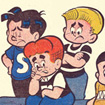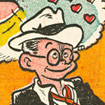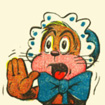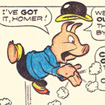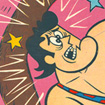I love how Superkatt and the other animals assume that super-powers come from costumes...and of course those "costumes" are basically just human clothes. I wonder if Gordon was consciously spoofing the fetishistic qualities of superhero costumes, when he decided to have Superkatt dress up as a big baby? In this issue, though, Our Hero takes a break from his infantilism to indulge in a little cross-dressing. Enjoy, kids!
Gordon's expressive characters are always a joy to see. Everyone is so anxious or angry all the time. Junior's expression and pose in the first panel of page four just kills me!
Here is Superkatt from Giggle Comics #27 (March 1946):






















































